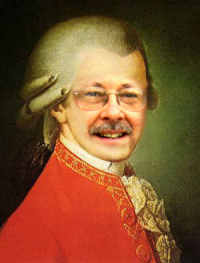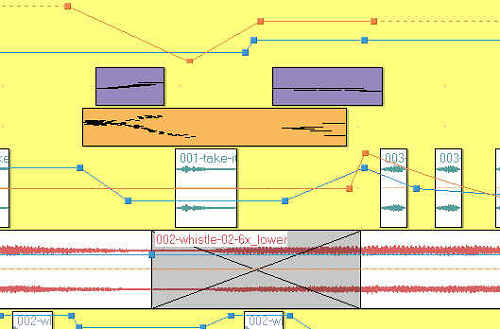A 365-Day Project
"We Are All Mozart"
A project to create
new works and change
the perception of the
music of our time.


 July 25, 2006
July 25, 2006 
They're bloviating over at the Arts Journal again with Is This The Best Of Times For Classical Music? (Or The Worst?), and it's like rubbing my soft palate with a pine cone. I read it and think, why am I doing this? I just know they're just going to pose more of the same questions we've been hearing for years and offer no solutions whatsoever -- especially solutions that might actually involve their action. Frank Oteri of New Music Box is there, and I hope he survives the equivocation that leaches off of everyone else. (One comment poster was put down with how great the critic was.)
Okay, enough of that. Read it to understand how powerless we still prefer to see ourselves as nonpop composers -- if you have your gag reflex under control.
Yesterday the topic was sources, and it was a general and reasonably fluffly look at possibilities. Why not a trek through the process of creating a one-minute electroacoustic piece? It'll be a new one, done today, because the actual nuts-and-bolts process of making music -- even those one-minute pieces done for 60x60 -- quickly fades from memory. All the drafts exist, but they're not enough to recall the process. So, then: something new.
The three sound sources came from a large library that's been building over the years. The library contains soundwalks through Vermont, New Jersey, Montana, California, Ireland and the European continent; sounds of spring peepers, human voices, and train whistles. Walking through crunching snow, going through a car wash, standing in a hydroelectric plant, crossing an intersection, setting off fireworks. For today's miniature, there are three sounds chosen almost at random: my voice saying "take it off" (from the sentence that included "...somebody asked that we take it off the site..."), a train whistling as it crossed nearby the house, and an intake of breath between some words -- three different sounds whose sonic richness isn't immediately evident.
A voice, a whistle, and a breath 
Will they be good for anything? Let's see...
Listening to the sounds several times is helpful, as well as shortening and stretching and knocking about with audio tools. Each sound was put through various simple processes, kept dry without reverb:
- The sound's pitch and speed transposed up ten times
- The sound's pitch and speed transposed down six times
- The sound reversed
- The sound with ping-pong reverb
- The sound granulated and remixed
- The sound spectrally transformed three different ways
- The sound's pitch transposed down eight times with no speed change
- The sound's pitch transposed up ten times with no speed change
- The sound's speed lengthened ten times with no pitch change
- A small portion of the sound trimmed midway and faded out
The voice put through transformations 
Some of these aren't very interesting or don't work well, but others are fine. Or so it seems for now. The up and down speed-pitch transpositions are useful, but the reversed sound is uninteresting, as is the ping-pong reverb. The granulation is fair, and the spectral transformations have a prettiness. The up-transposition is an interesting flash of color, but the down-transposition has too many artifacts of the software's clumsy transposition process. Finally, the small trimmed portion sounds "musicky" and might make a useful quasi-instrument. In fact, here's a little chromatic scale created from the trimmed vocal sound:
An ascending scale from a trimmed syllable 
A little silly playing all by itself, but not too bad. The train whistle was put through the same set of transformations, but with some quite different results. Keep in mind this is all a matter of taste, and I'm not as fond of 'noisy' sounds as other composers.
The train whistle put through transformations 
Unlike the voice, the sets of colors and textures don't significantly belie their origins. The speed-pitch up transposition sounds more like a bird cry, but the reversed sound hardly changes character. Some of the spectral transformations are mildly attractive, but the speed stretching has no character and leaves many artifacts. On the other hand, the trimmed sound also sounds "pitchy" and transposed down is a kind of thudding dry bass. (Purer electroacousticians are not always fond of resolving sounds into instrumental characteristics, but it's worth seeing where all this might go.) As I type these words, I am also taking breaks to work through the next steps on the way to creating the piece. Here is a descending chromatic bass scale built from the trimmed train whistle:
A descending scale from a trimmed whistle 
That leaves the breath, which is entirely noise filtered by the shape of the mouth. Transformation of noise doesn't always yield interesting results, but some of these suggest possibilities. The breath 'roar' has nice texture, the reverse sound has a descriptive intake character, the spectral transformations are weak but useful, the normal-speed down-pitch is animal-like, but the lengthening is so filled with artifacts of the software transformation process that it's useless. And then there's that little trimmed and faded sound at the end.
The inhale put through transformations 
That ending sound is intriguing, yes. Put together in a bunch, they sound like this:
A rapid sequence from a trimmed breath 
So there is the raw material. What to do with it? Let's go the traditional 'notey' route with a low propulsion of the sound from below, and a soundscape feel, with sound objects appearing and disappearing from the space. That's the goal right now, a bit before noon.
Five Hours Later
The little piece is done. In thinking about these three cheerful sounds -- voice, whistle, breath -- I decided to turn them dark, bringing the intenseness of the lower sounds into play. Hollow walls of reverberation surround the sounds as they grow and recede and move into, out of, and across the acoustic space. Beyond placement, reverberation, and space motion, very little further was done to the transformed set of sounds except to imagine them as part of a whole composition.
Below is a small clip of the assembly process (done in Sonar). One might think of it as orchestrating the electronic sounds, but in ways acoustic musicians can't achieve. The red lines are pan (left-right placement), the blue lines are volume. The sound cliips are shown as waves, and the purple and orange segments contain lines of Midi information. Instead of hundreds of little sounds being put in place one at a time, a set of acoustic samples was packed into a 'soundfont' and the Midi was used to play the individual sounds from the chromatic whistle and voice scales presented in the clips above. And last of all in this image, the overlapping gray area is a crossfade of two sound clips.
Clicking on the sample segment above will open a large image in a new window, showing the nine tracks more clearly (though still squeezed from the expanding and scrolling display one would actually use to create the composition). Each clip created earlier is named in place, and its waveform shape is shown. But what does it all sound like? Here is the final piece, which I called chartrelian. It could use some mastering and a little more spaciousness, for which I normally use additional software, but let's declare this one done.
Three sounds, five hours, and a tiny electroacoustic composition is imagined into existence.
